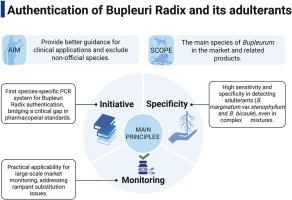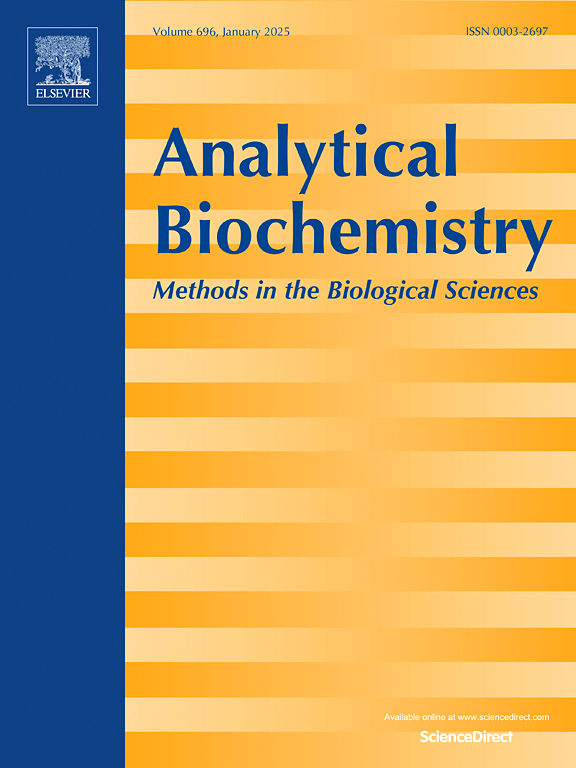药用植物柴胡及其常见掺假物种特异性PCR鉴定方法的建立
IF 2.5
4区 生物学
Q2 BIOCHEMICAL RESEARCH METHODS
引用次数: 0
摘要
柴胡是一种应用广泛的中草药植物,其官方来源为中国药典认可的柴胡干根。或柴胡,野柴胡。虽然两种植物共享核心治疗功能,但化学成分类型的差异导致了不同的临床应用。目前,药典标准中未对两种进行区分。因此,我们假设根据其药理特点分别处方可能会有更好的临床疗效。此外,柴胡壁。交货。var stenophyllum (Wolff) Shan et Y. Li和Bupleurum bicaule Helm经常被误用为柴胡根。为了解决上述问题,我们开发了针对ITS区域的物种特异性PCR。252bp、183bp、272bp和165bp的片段分别对应于B. chinense、B. scorzonerifolium、B. marginatum vars . stenophyllum和B. bicaule。即使在分析人工掺假样品时,PCR也表现出较强的判别能力。此外,对商业样本的分析验证了物种信息的准确性。综上所述,物种特异性PCR能够准确鉴别柴胡和市场上常见的掺假物。为柴胡的质量控制提供了实用的工具,为中草药生产的标准化提供了支持。本文章由计算机程序翻译,如有差异,请以英文原文为准。

Development of species-specific PCR for authentication of medicinal plant Bupleuri Radix and its common adulterants
Bupleuri Radix is a widely used herbal plant, and its official source recognized by Chinese pharmacopoeia is the dried roots of Bupleurum chinense DC. or Bupleurum scorzonerifolium Willd. Although two species share core therapeutic functions, differences in the types of chemical components lead to different clinical applications. Currently, two species have not been distinguished in pharmacopeial standards. Therefore, we hypothesize prescribing them separately based on the pharmacological characteristics may provide better clinical efficacy. Additionally, Bupleurum marginatum Wall. ex DC. var stenophyllum (Wolff) Shan et Y. Li, and Bupleurum bicaule Helm were often misused as Bupleuri Radix. To address above issues, we developed species-specific PCR targeting ITS region. The observed fragments of 252bp, 183bp, 272bp and 165bp correspond to B. chinense, B. scorzonerifolium, B. marginatum var. stenophyllum, and B. bicaule respectively. The PCR exhibited strong discriminative capability, even when analyzing artificial adulterate samples. Furthermore, analysis of commercial samples validated the accuracy of the species information. In summary, the species-specific PCR enables accurate authentication of Bupleuri Radix and common adulterants in the market. It provides a practical tool for quality control of Bupleuri Radix and supports standardization of herbal medicine production.
求助全文
通过发布文献求助,成功后即可免费获取论文全文。
去求助
来源期刊

Analytical biochemistry
生物-分析化学
CiteScore
5.70
自引率
0.00%
发文量
283
审稿时长
44 days
期刊介绍:
The journal''s title Analytical Biochemistry: Methods in the Biological Sciences declares its broad scope: methods for the basic biological sciences that include biochemistry, molecular genetics, cell biology, proteomics, immunology, bioinformatics and wherever the frontiers of research take the field.
The emphasis is on methods from the strictly analytical to the more preparative that would include novel approaches to protein purification as well as improvements in cell and organ culture. The actual techniques are equally inclusive ranging from aptamers to zymology.
The journal has been particularly active in:
-Analytical techniques for biological molecules-
Aptamer selection and utilization-
Biosensors-
Chromatography-
Cloning, sequencing and mutagenesis-
Electrochemical methods-
Electrophoresis-
Enzyme characterization methods-
Immunological approaches-
Mass spectrometry of proteins and nucleic acids-
Metabolomics-
Nano level techniques-
Optical spectroscopy in all its forms.
The journal is reluctant to include most drug and strictly clinical studies as there are more suitable publication platforms for these types of papers.
 求助内容:
求助内容: 应助结果提醒方式:
应助结果提醒方式:


